This is the fastest and easiest way to study for the General Knowledge Exam, for a Class A CDL. Below I have taken the necessary sections from the CDL manual, and condensed them into their most simplistic form.
To ensure their viability, I have taken various forms of the test and searched for the answers within my own summarized version of the manual. I am proud to inform you that this manual, though simplified, is fully comprehensive of the necessary materials for you to pass your exam.
With that being said please read all the material in this section, none of it is fluff, and you will need to have a good working memory of the material for your exam. Take a deep breath, you can do this!
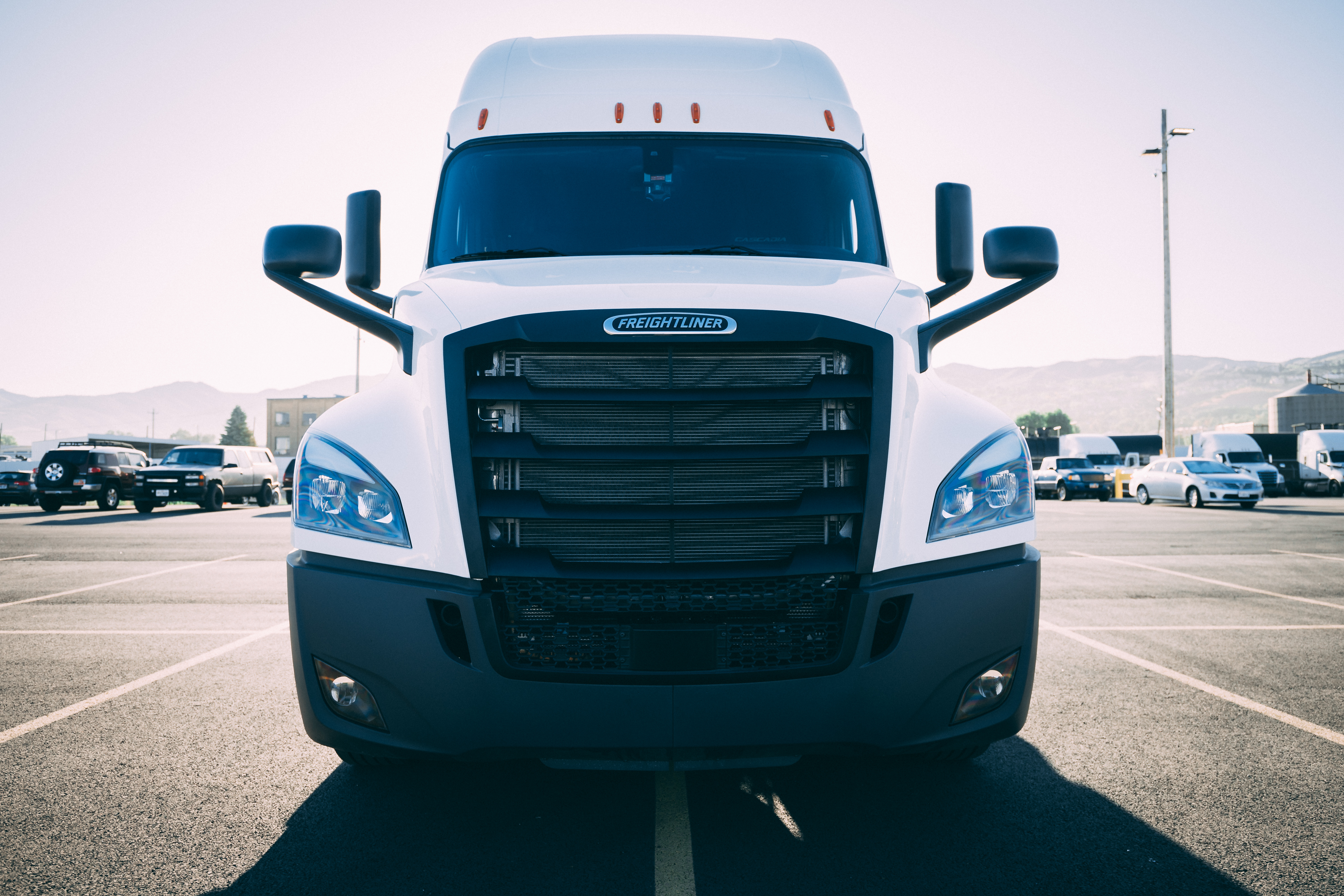
Section 1: Introduction
You must have a CDL to operate:
- Any vehicle with a GVWR (gross vehicle weight rating) of 26,001 lbs or more.
- Any combination vehicle GVWR 26,001lbs or more, and if towing, that being towed must exceed 10,000 lbs.
- A vehicle designed to transport 16 or more passengers.
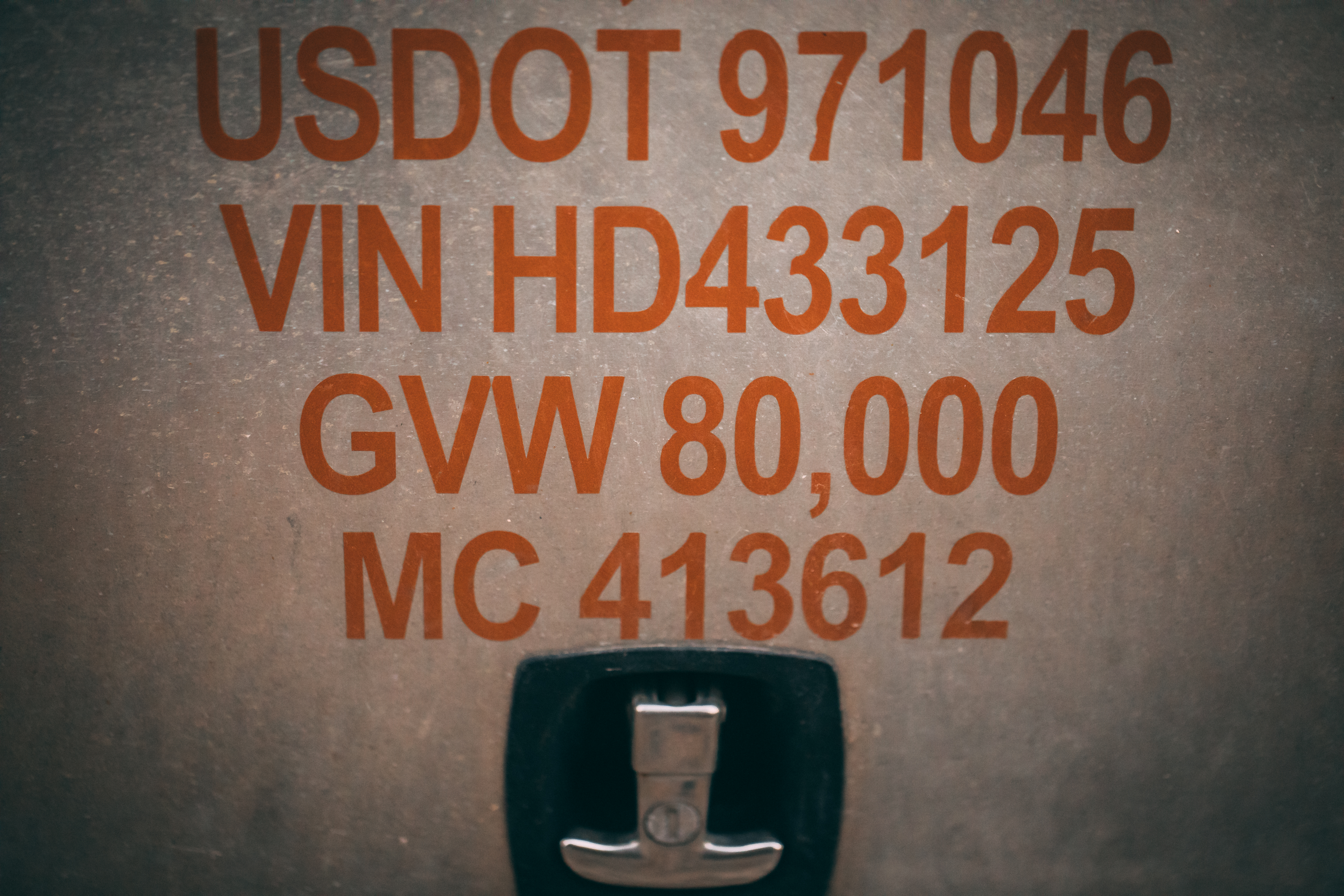
Medical Documentation
You will need a DOT medical certificate and state driver’s license to drive legally, and cannot take your exams without it.
Interstate vs Intrastate
If you travel outside of your state you are “interstate” if not your are “intrastate”. I’m also guessing none of you are transporting emergency equipment and supplies, or work for a funeral home so you will be “non-excepted”. You will most likely check the box Interstate Non-Excepted when you apply for your permit.
CDL Disqualifications
1. Loss of CDL for at least a year for a first offense of any of the following:
- Having a blood alcohol concentration .04% or more, and operating a CMV.
Driving a CMV consents you to alcohol testing, so don’t be dumb.
You will be put out of service for any BAC detectable under .04% for 24 hours. - Driving under the influence of any substance (controlled or alcohol).
- Refusing to undergo blood alcohol testing.
- Leaving the scene of an accident involving a CMV.
- Committing a felony involving the use of a CMV.
- Driving a CMV when your license is suspended.
- Causing a fatality through negligent operation of a CMV.
Loss of CDL for life for a second offense, or for using a CMV to commit a felony involving controlled substances. The suspension for the first offense will be extended to 3 years for a hazmat CMV.
2. Serious Traffic Violations
- Excessive speeding (15mph or more over the posted speed limit)
- Reckless driving
- Improper or erratic lane changes
- Following too closely
- Traffic offenses connected with a CMV and a fatality.
- Driving a CMV without obtaining or carrying the correct CDL with the necessary endorsements
Loss of CDL for at least 60 days for committing two serious traffic violations, involving a CMV, in a three year period.
Loss of CDL for at least 120 days for committing three or more serious traffic violations, involving a CMV, in a three year period.
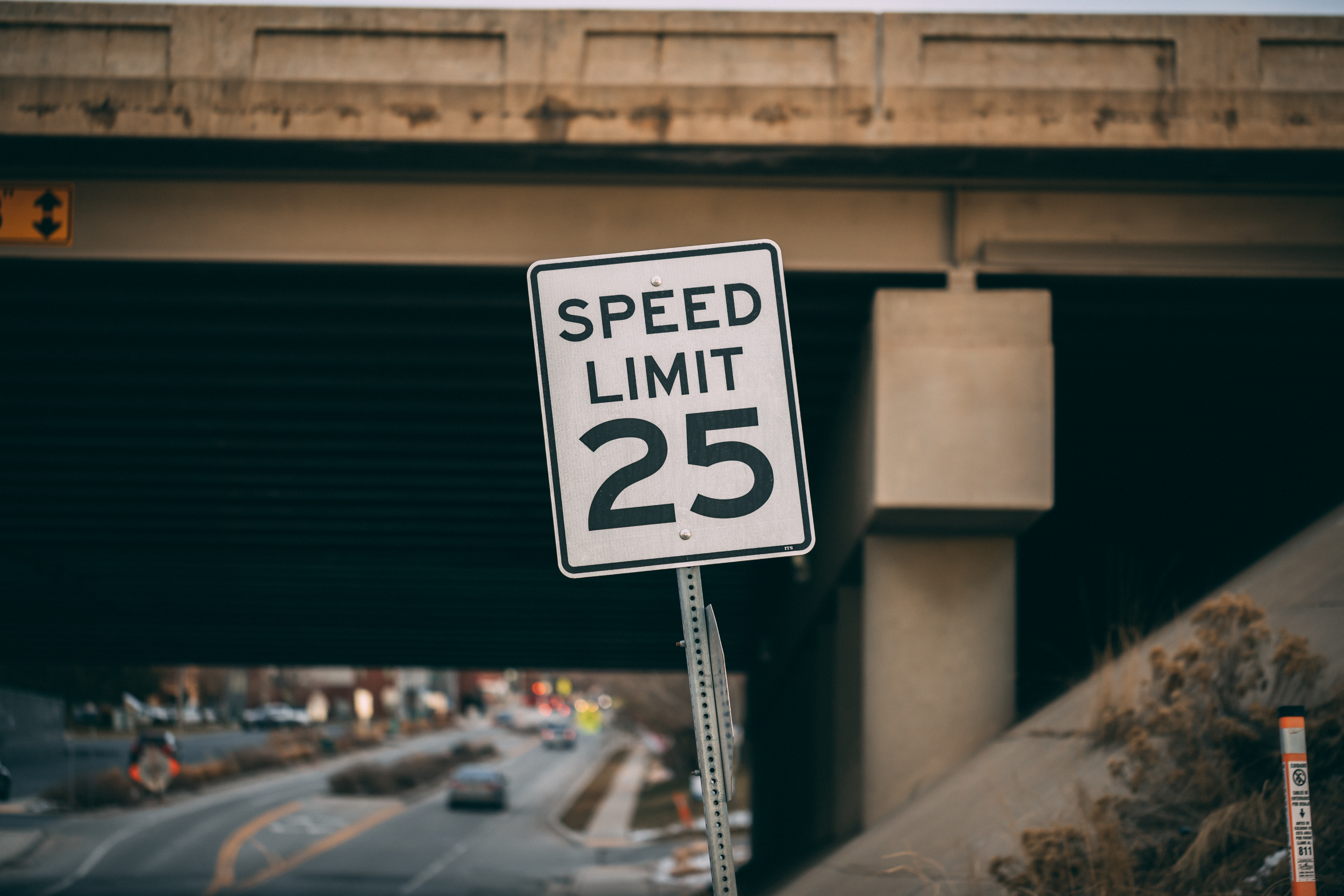
3. In Violation of Out-of-Service Orders
Loss of CDL for at least…
- 90 days for first offense
- A year for two offenses in a ten year period
- Three years for three or more offenses in a ten year period
4. Railroad of Highway Grade Crossing Violation
- (Drivers not required to stop) Failure to stop before reaching the crossing if the crossing isn’t clear.
- (Drivers not required to stop) Failure to slow down and check for a train before crossing.
- (Drivers required to stop) Failure to stop before the crossing.
- Driving through a railroad crossing if you do not have sufficient space to clear the crossing without stopping.
- Failure to obey traffic control devices or enforcement personnel.
- Failure to clear the crossing due to loss undercarriage clearance.
Loss of CDL for…
- 60 days for first violation.
- 120 days for second violation within a three year period.
- One year for three or more violations within a three year period.
5. Hazardous Materials
If you want to get this endorsement you must submit fingerprints and subject yourself to a background check. You can loss or fail to gain the endorsement if you do or have any of the following.
- If you are not a lawful permanent resident of the USA, or renounce your citizenship.
- You are wanted or under indictment for certain felonies.
- Have a conviction for certain felonies (in military or civilian court).
- You are not mentally sound, and have been committed to a mental institution.
- Transportation Security Administration deems you a threat.

6. Traffic Violations (Personal Vehicle)
You will be disqualified from operating a CMV if you have any of the following.
- Your ability to drive your personal vehicle is revoked, canceled of suspended due to violations other than parking tickets.
- Your ability to drive your personal vehicle is revoked, canceled or suspended due to felony violations, alcohol or controlled substances.
- Loss of CDL for one year for first offense.
- Loss of CDL for life for a second offense
- You cannot obtain a “hardship” license to operate a CMV if your license to operate a personal vehicle is revoked, canceled or suspended for any reason.
7. Other CDL Rules
- You cannot have more than one license. (Fine up to $5000, or arrest)
- You have to notify your employer of any traffic violations, except parking, within 30 days
- If your license is suspended, canceled or revoked you have to notify your employer with two business days.
- You have to provide an accurate driving record history for the past 10 years when applying to any employer for a driving position.
- You cannot drive a CMV without a CDL (Fine up to $5000, or arrest)
- Surrender your Hazmat certification if you legally lose it (look at Hazardous Materials)
- Don’t use a hand held mobile device and drive, it’s a no-no.
- You must always wear your seat belt. (duh…)
International Registration Plan and
IFTA (International Fuel Tax Agreement)
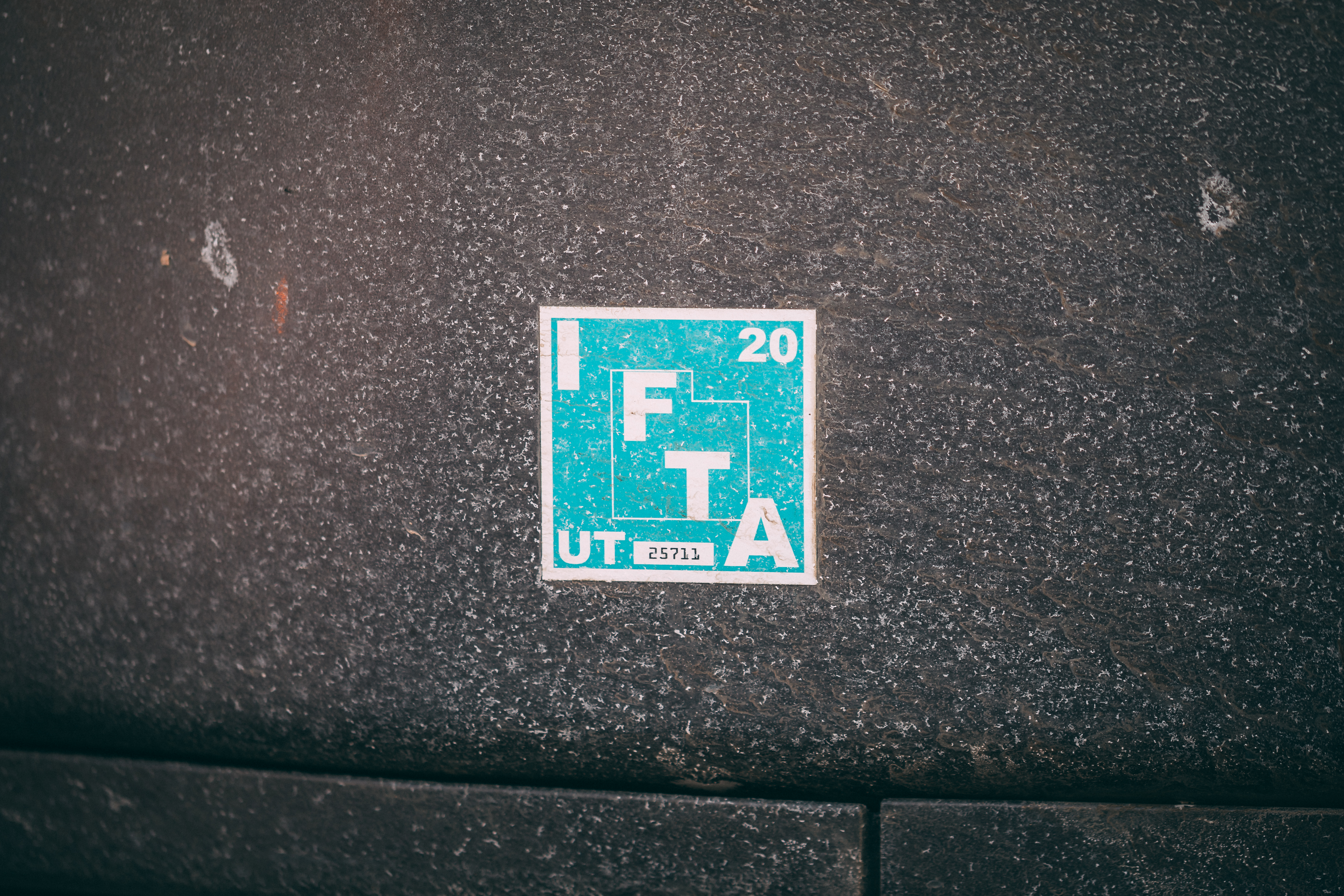
Section 2: Driving Safely
- SAFETY is the most important reason you inspect a vehicle!
Vehicle Inspection Types
Please reference section 2.1 in the official CDL Manual. Do not skip out on studying this section! It is terribly important.
(I am currently working on an updated version with videos and figures)
Basic Controls Of The Vehicle
1. Accelerating
- Don’t roll back when you start.
- Rough or jerky acceleration can cause damage to the tractor and coupling devices, if towing.
- When traction is poor accelerate gradually, don’t spin tires.
2. Steering
- Hold wheel with both hands on opposite sides of the wheel.
- Potholes or other road obstacles may jerk your truck, you need to have a good grip to maintain control.
3. Stopping
- Always slow gradually, with light and increasing pressure to the brake pedal.
- If manual, press in clutch when engine speed nears idle.
4. Backing Safely
- Start in the proper position (This is relative to the location, and where you have to park the truck)
- Look at the path your vehicle is going to take. Get out and look.
- Use mirrors
- Back slowly
- Back toward the driver’s side (sight-side) whenever possible.
- Use a helper
Shifting Gears
Seeing
1. Seeing Ahead
- You need a lot of distance to make proper lane changes and to stop your rig.
- Attempt to look ahead 10-15 seconds.
- Multitask looking near and far while you drive.
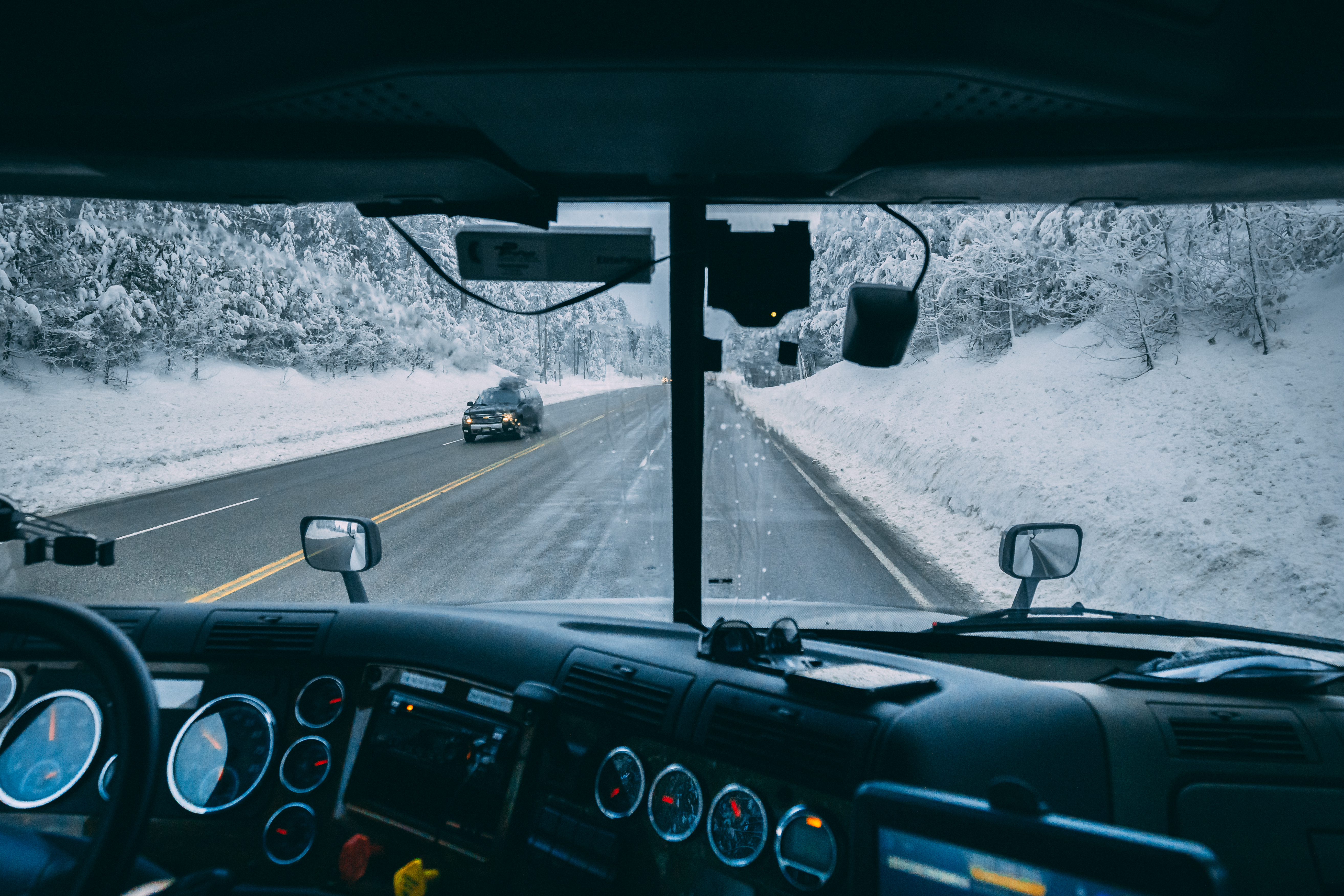
2. Seeing to the Sides and Rear
- You need to check the adjustment of your mirrors in your pre-trip.
- Having part of the vehicle visible in each mirror will allow you to have a reference point.
- Check your mirrors regularly while driving, vehicles can come into your “blind spots” and if you can catch them before they are unseen, you can better avoid potential accidents.
- Make sure to check your load and trailer in your mirrors as well to catch blown tires, unsecured load straps, etc.
- Check your mirrors more often during lane changes, turns, etc.
- When checking your mirrors do so quickly and do not fixate on the mirror itself because you will be unaware of the changing road conditions ahead of you.
- The smaller curved mirrors are CONVEX mirrors. They show a wider area making the objects in them look SMALLER and FARTHER away.
Communicating
1. Signaling Your Intentions
- “The OG of instant messaging is the turn signal”, I stole that one from a DOT sign.
- When turning: signal early, continuously and don’t turn it off until you’ve completed your turn.
- When changing lanes: Signal before, change lanes slowly. There may be someone in your blind spot you didn’t see.
- As you are slowing down you can use flashers to warn other drivers. These situations could be trouble ahead, tight turns, stopping on the road, or driving slowly.
2. Communicating Your Presence
- In certain situations you may need to communicate your presence by flashing your lights or honking your horn.
- Some of these incidents include when passing a pedestrian or other motorist on the road, when visibility is bad, and when parked on the side of the road.
- Using reflective triangles or flares: These must be placed out within ten minutes of stopping the vehicle.
Divided Highway
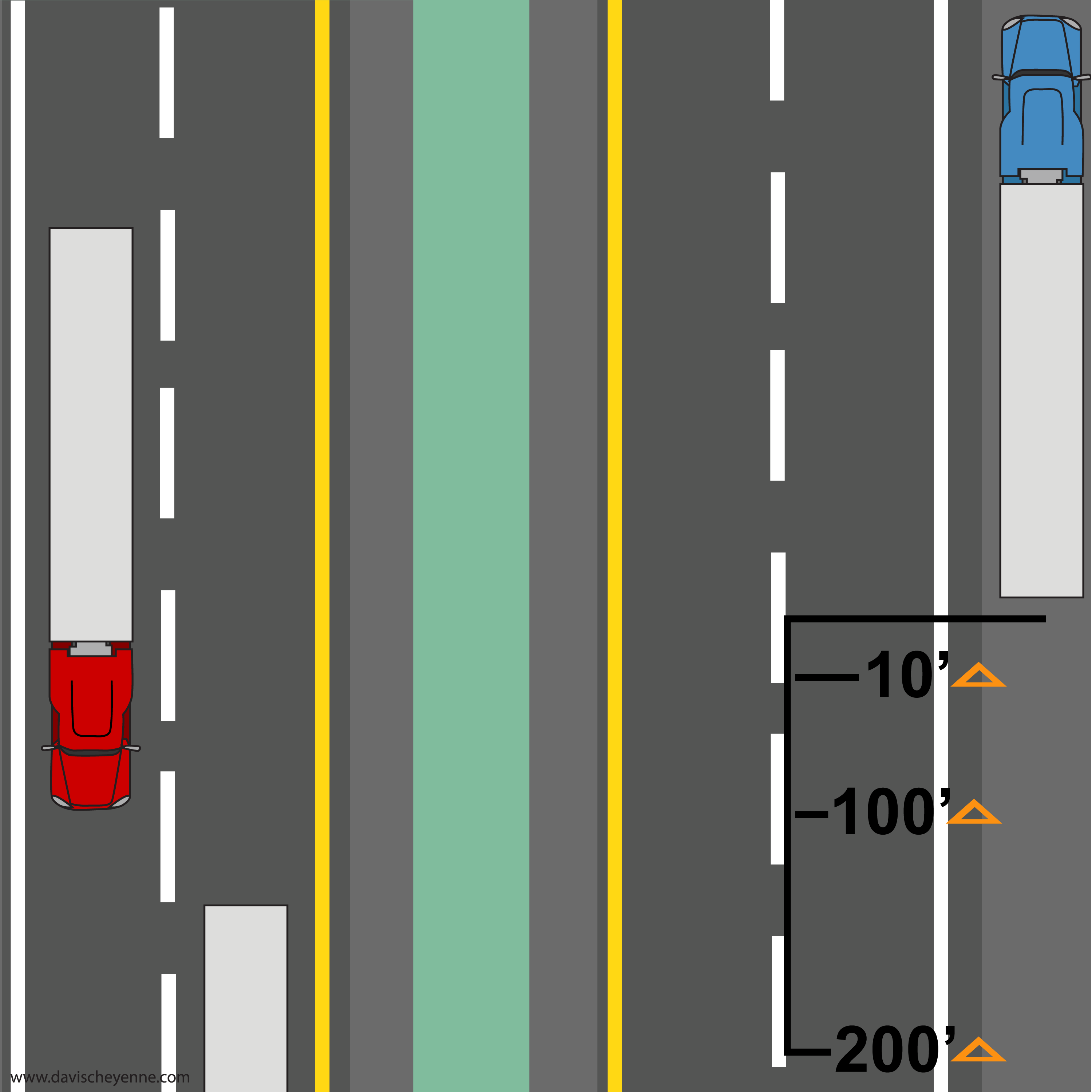
Undivided Highway
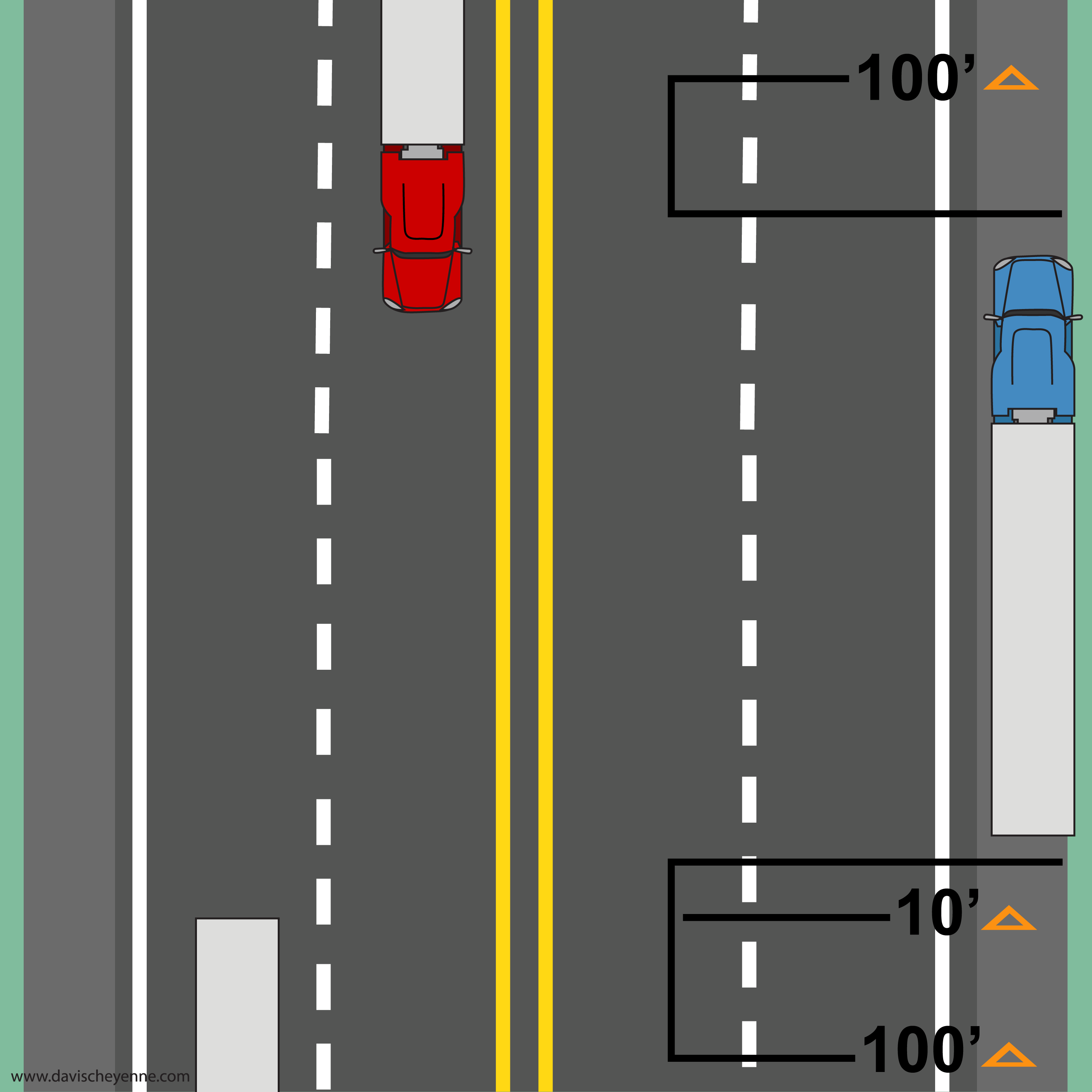
Hills or Curves (Obstructed Views)
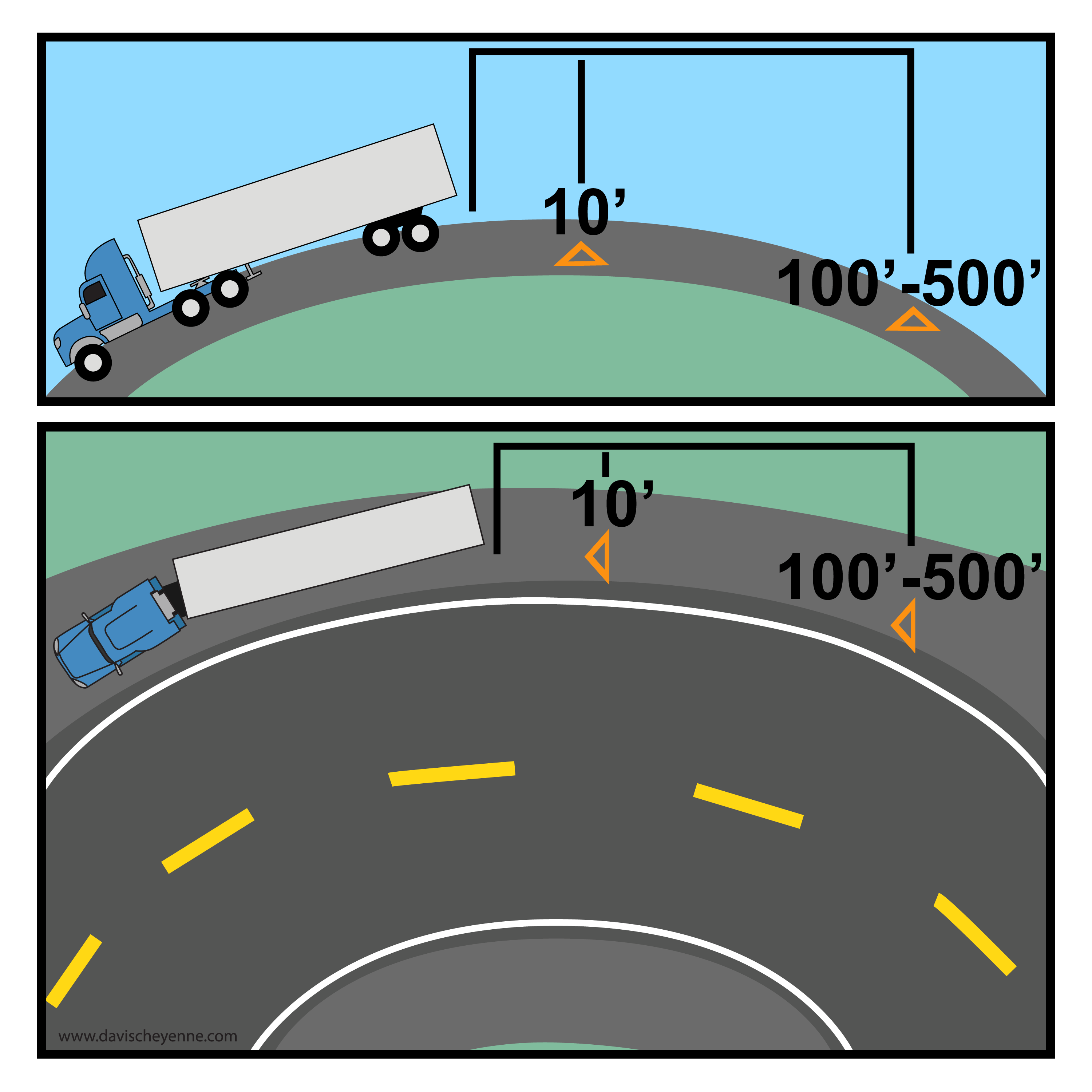
Controlling Speed
1. Stopping Distance
- Perception Distance + Reaction Distance + Braking Distance = Total Stopping Distance
- Increasing your speed increases your stopping distance.
- Accelerating from 20 mph to 40 mph you increase your impact and braking distance by four times.
- From 20 mph to 60 mph you increase your impact and braking distance by nine times.
- From 20 mph to 80 mph you increase your impact and braking distance by sixteen times.
- 60 mph stopping distance is greater than a football field.
- EMPTY trucks require greater stopping distances, due to reduced traction.
2. Road Surface
- Slippery surfaces: take longer to stop, harder to turn, double stopping distance.
- Lower speed by one third in wet conditions.
- If there is packed snow reduce speed at least by half.
- If you are on ice reduce speed to a crawl, and pull over and stop driving as soon as possible.
- You can look for signs for potentially slippery roads. These can be in shady areas where the temperatures are cooler, under and over bridges, melting ice (which is more slippery than completely frozen ice), black ice, ice accumulating on your vehicle, right when it first starts raining and if you are beginning to hydroplane.
- Hydroplaning can occur at speeds as low as 30 mph, and is more likely with under inflated worn out tires, due to decreased tread depth.

3. Curves
- You need to slow down for curves. If you proceed too fast two things can happen.
- Your tires lose traction and you begin to skid, in a straight path off the road.
- Your tires maintain traction and you roll over.
- Even at posted speed limits, your truck can roll over, if the center of gravity is high enough.
- You need to slow down enough before a curve so you can slowly accelerate out of it.
- Avoid braking while in a curve because your tires are more prone to losing traction.

4. Distance
- Do not reach speeds where you can no longer see as far ahead as the distance you need to stop. This is especially true in low visibility conditions (rain, fog, snow, etc.)
5. Traffic Flow
- Driving the same speed as traffic is the safest when in heavy traffic conditions.
- Speed limits for trucks and buses can vary in big cities as much as 15 mph. In these conditions take extra caution when changing lanes to look for other vehicles quickly appearing near you or in your blind spots.
- You are not allowed to go over the posted speed limit even if traffic is moving faster than you.
6. Downgrades
- Do not exceed to posted maximum safe speed for the downgrade.
- Your main braking control should be the braking power of the engine for downgrades.
- The engine braking effect is greatest when the transmission is in lower gears.
7. Work Zones
- Speed is the number one cause of work zone accidents.
- Decrease speed further when a road worker is near the travel lane.

Managing Space
1. Space Ahead
- At speeds below 40 mph leave 1 second of space for every 10 ft of vehicle.
- At speeds above 40 mph leave 1 extra second for safety
- Examples: (for a 50 ft vehicle)
- 30 mph = 5 seconds
- 70 mph = 6 seconds
2. Space Behind
- Stay to the right
- If you are being tailgated you can avoid accidents by avoiding abrupt changes to your driving like stopping and changing direction quickly.
- Don’t brake check drivers
3. Space to the Sides
- Stay centered in your lane and avoid travelling next to others.
- Strong winds can push you into other vehicles especially coming out of tunnels, watch for vehicles travelling next to you.
4. Space Overhead
- Always watch for bridge heights and overhead objects.
- A trailers weight can change it’s height.
- Before backing look for overhead obstacles.
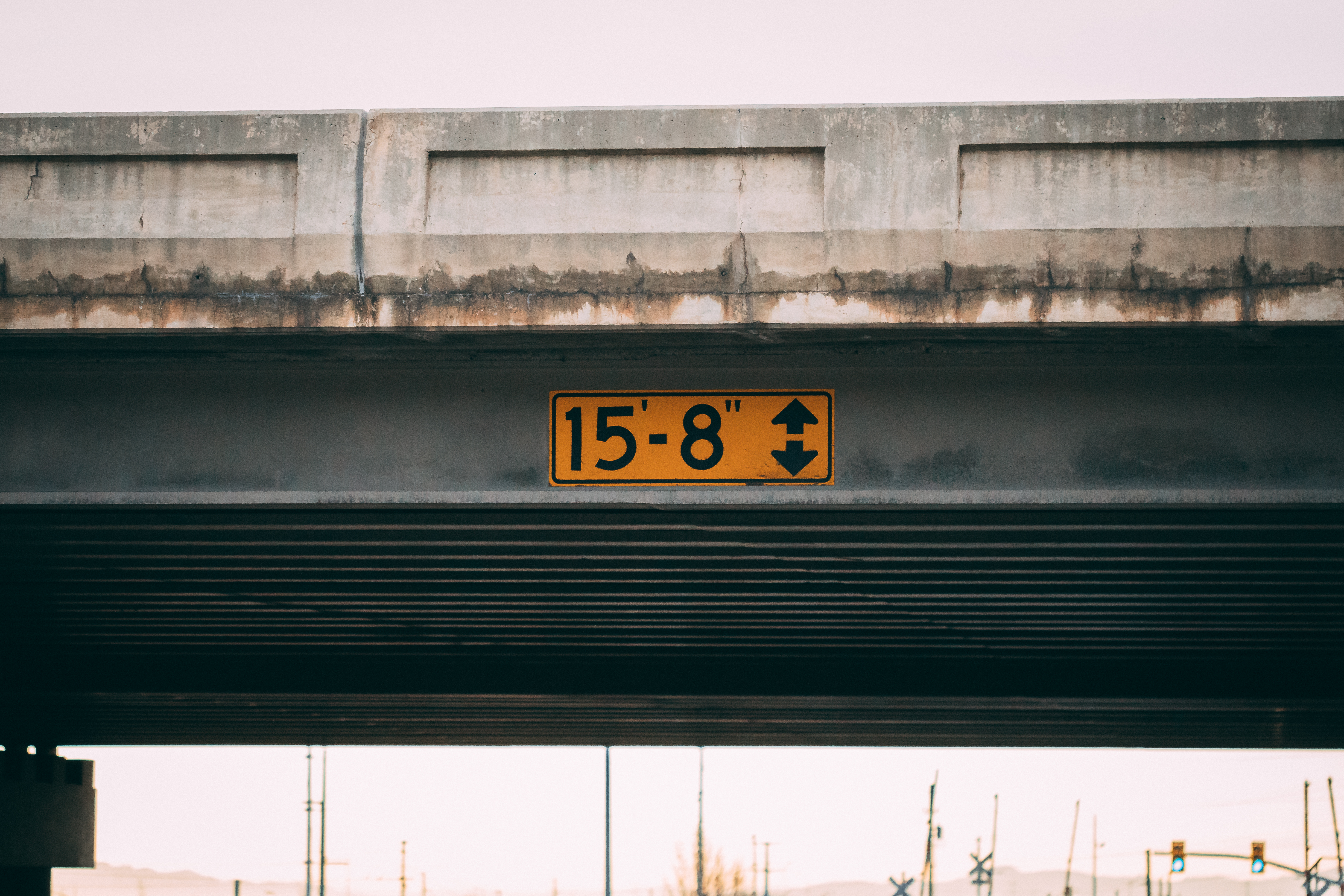
5. Space Below
- Heavily loaded trailers can lessen the clearance space underneath the trailer.
- Take care on unpaved and uneven roads
- Low trailers should take extra care when crossing railroad tracks.
6. Space for Turns
- Right turns: Turn slowly, Don’t swing out into on-coming traffic to your left.
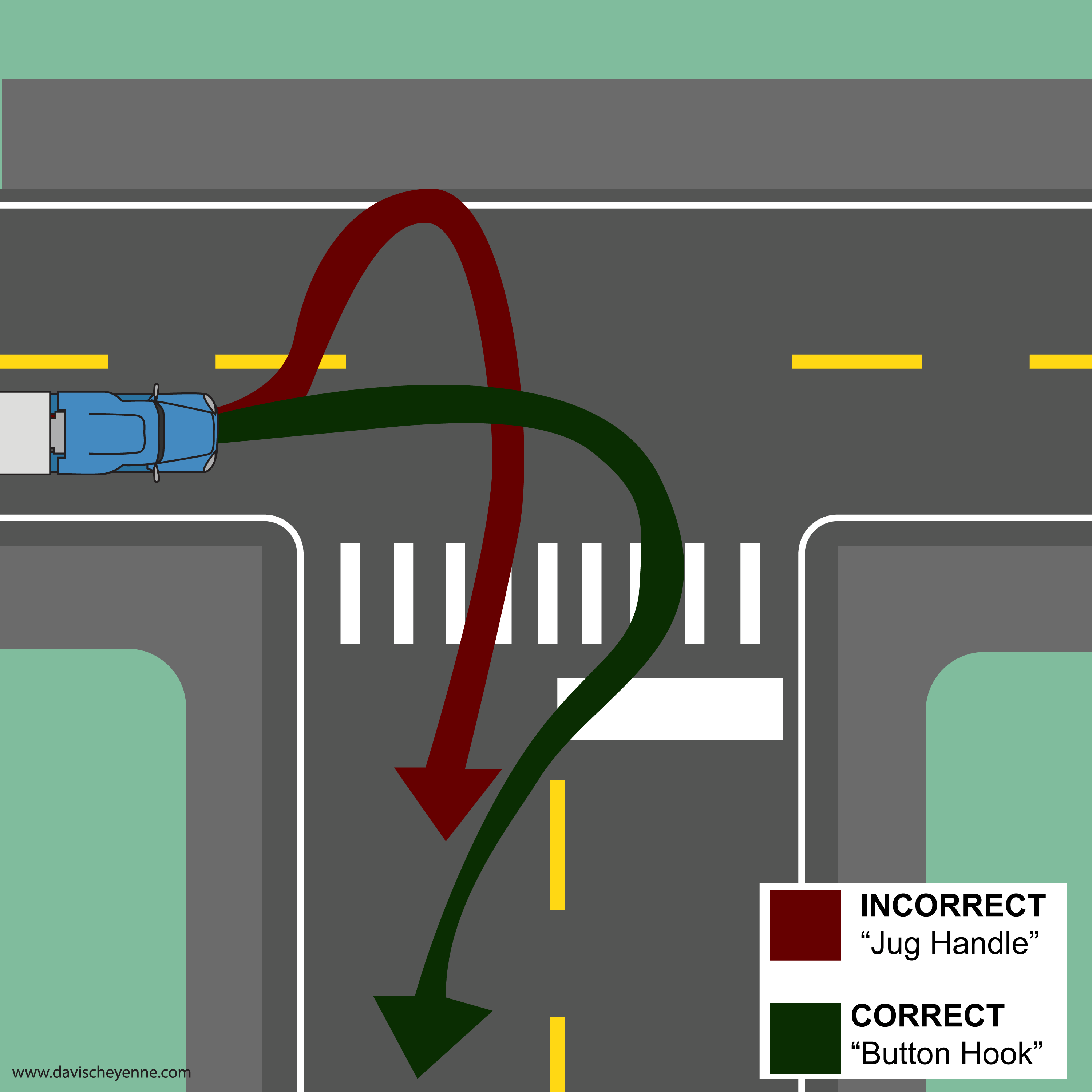
- Left turn: Always use the left turn lane furthest to the right.
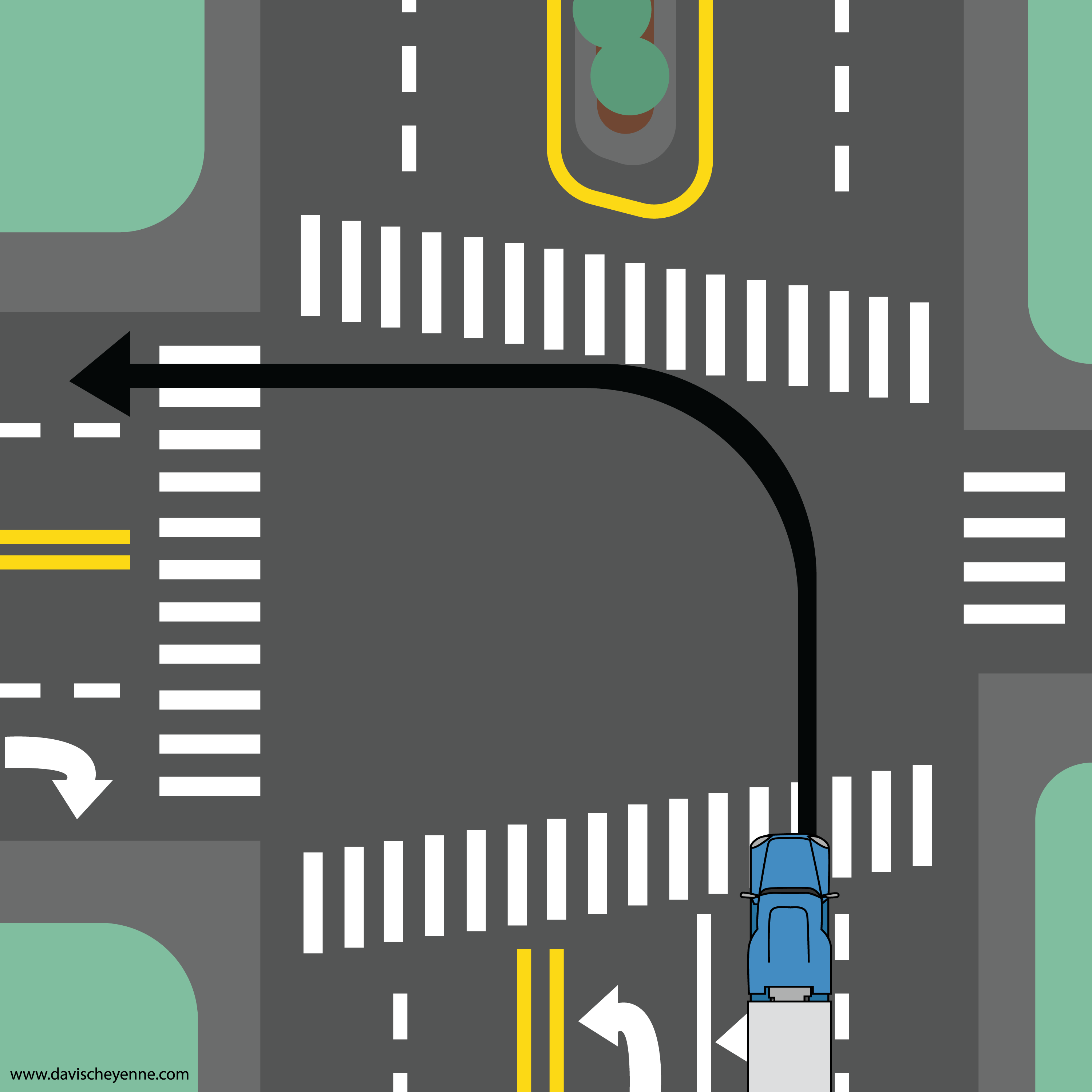
7. Space Crossing and Entering Traffic
- You need a large space to cross or enter traffic due to the size and weight of your vehicle.
- A heavily loaded vehicle accelerates rather slowly so time is a huge factor.
Seeing Hazards
1. Why it is important?
- You want to be on the look out for hazards before they become problems so that you have more time to react to them to avoid accidents.
2. Hazardous Roads
- When ever you see a working, emergency, or official vehicle on the side of the road it is the law in many states to slow down move over when passing them. If you cannot safely make a lane change you are required to slow down and proceed with extreme caution.
- Always use caution going through work zones. Workers or equipment may be close to or move into the roadway.
- Occasionally there are areas on roads where there is an abrupt edge or drop off. These can be especially dangerous for trucks. A drop off to either side, if severe enough can tip your truck or lean your truck where the top may hit overhead obstructions. If you must drive off or onto a drop of, do so slowly and carefully the wheel may jerk.
- Watch out for objects in the roadway.
- On ramps and off ramps for bigger vehicles can be especially tricky sometimes. There are usually cautionary speed limits posted on these ramps to warn drivers of the danger. You may need to slow down below these limits to take the ramps safely.
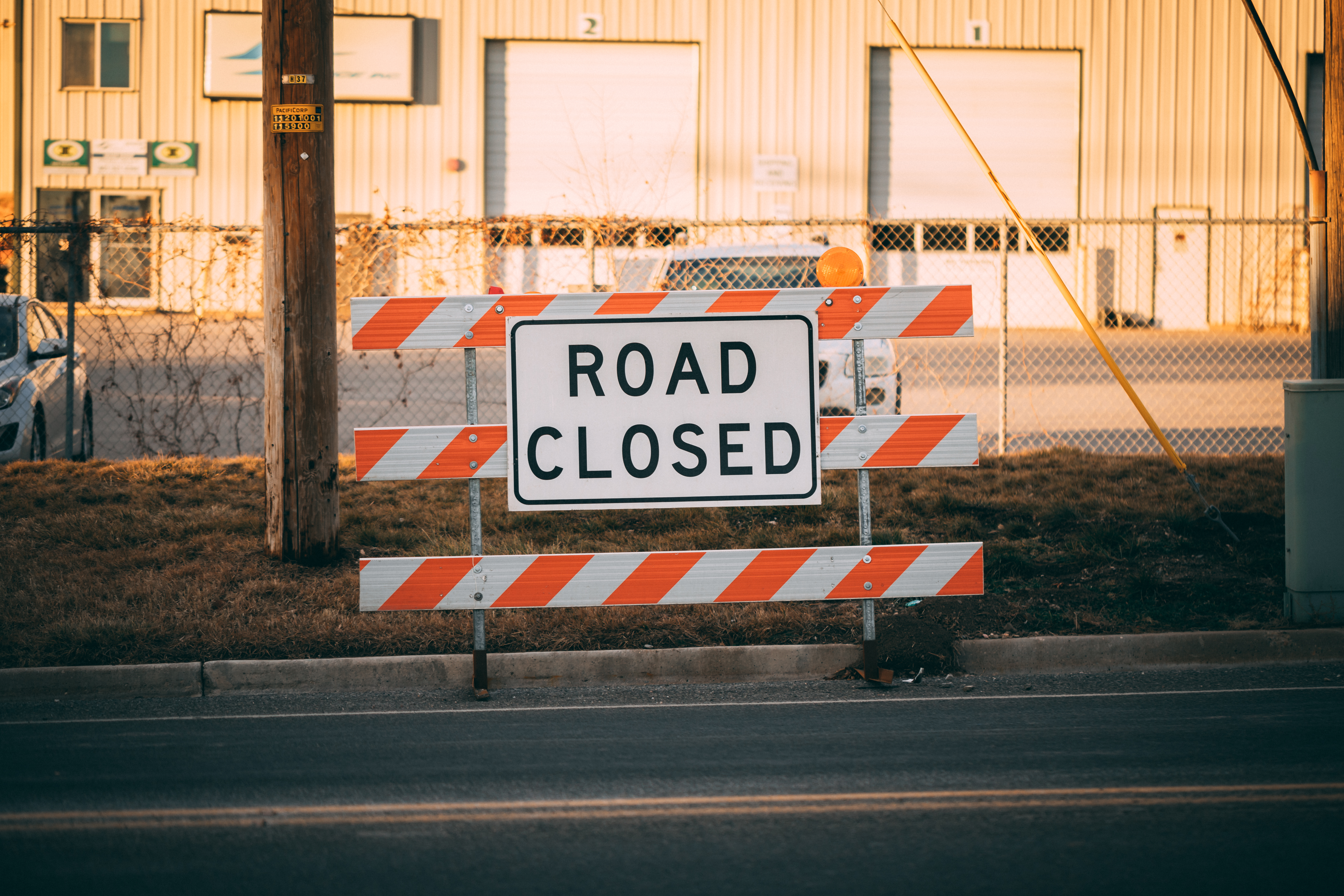
3. Other Road Hazards
- Drivers with limited vision
- Delivery trucks
- Stopped vehicles
- Pedestrians and bicyclists
- Distracted people
- Children
- Talkers
- Workers
- Ice cream trucks
- Disabled vehicles
- Accidents
- Shoppers
- Confused drivers
- Slow drivers
- Drivers signaling a turn
- Drivers in a hurry
- Impaired drivers
- Drivers moving their body in a direction (indicating they might turn or lane change)
- Areas of conflict (lane ends, merges, intersections)
4. Having a plan
- Be prepared and have a plan to avoid different hazards.
Distracted Driving
1. Activities that Cause Distracted Driving
- Talking to passengers
- Changing the radio, AC controls
- Eating, drinking, smoking
- Reading maps, newspaper etc.
- Picking up something that fell
- Talking on phone or CB radio
- Texting
- Using any type of electronic device (GPS etc.)
- Daydreaming
2. Statistics of Distracted Driving
- The Large Truck Crash Causation Study
- 8% of large truck crashes occurred when a CMV driver was externally distracted
- 2% of large truck crashes occurred when the CMV driver was internally distracted.
- NHTSA Traffic Safety Facts: Distracted Driving
- About 5,500 people are killed each year on US roadways.
- 448,000 people are injured each year due to distracted drivers.
- Talking on a cell phone (even if hands free) takes 39% of the total energy normally used to drive safely.
- Using a hand held device makes you more likely to be involved in an injury causing accident.
3. Effects of Distracted Driving
- Slowed perception
- Delayed decision making
- Improper action
4. Types of Distractions
- Physical distraction – a distraction that removes your hands from the driving wheel of the vehicle or your eyes from the road
- Mental distraction – daydreaming, talking to passenger in the vehicle, etc.
- Both physical and mental distraction – talking on the phone or texting
5. Mobile Phones
- Motor carriers are prohibited from allowing or requiring their CMV drivers to using a handheld mobile phone.
- (Directly from the manual) The use of hand-held mobile telephones means “using at least one hand to hold a mobile telephone to conduct a voice communication”,”dialing a mobile telephone by pressing more than a single button” or “moving from a seated driving position while restrained by a seat belt to reach for a mobile telephone”.
- While operating a CMV you can only use a hands free mobile telephone device.
- Disqualification of CDL
- Your CDL will be disqualified after the second offense for 60 days within a 3 year period.
- Your CDL will be disqualified after the three or more offenses for 120 days within a 3 year period.
- You can use a hand held phone only if it is an emergency and you are communicating with emergency personnel.
6. Texting
- Disqualifications are the same for using a mobile phone and driving a CMV.
- Don’t text and drive.
7. Distracted Driving
- You can limit distractions by identifying and putting away distractions, being familiar with the controls of your vehicle before operating it, and having a plan when distractions occur.
8. Watching for Distracted Drivers
- A driver might be distracted if there is excessive movement in the vehicle, the vehicle is drifting in and out of lane, the vehicle has inconsistent speeds, etc.
Aggressive Driving
1. What is aggressive driving?
- Aggressive driving: “the act of operating a motor vehicle in a selfish, bold, or pushy manner without regard for the rights or safety of others.”
- Road rage: “operating a motor vehicle with the intent of doing harm to others or physically assaulting a driver or their vehicle.”
2. Confronting Aggressive Drivers
- Don’t make eye contact
- Get out of their way if possible
- Report aggressive driving to the proper authorities
- If they are later involved in a crash, stop away from the accident scene and wait to provide a statement about the driving behavior you witnessed.
Driving at Night
1. Hazards of the Driver
- You need good vision to drive safely, always have the necessary corrective eye ware and have your eyes checked regularly.
- Be careful of bright lights or glare, they can temporarily blind you.
- Drivers can become more tired at night. Fatigue can cause impairments in functionality and judgment. Don’t drive drowsy.
- If you are tired while driving the only cure is SLEEP.
2. Roadway Hazards
- Poor lighting
- Drunk drivers
3. Vehicle Hazards
- Headlights are your only source of light in the night time. With your low beams you can see approximately 250 ft ahead of you, and with your high beams, 350-500 ft.
- Travel at the speed you can stop within the view of your headlights.
- You need to make sure other visibility indicators are functioning properly, such as, signal lights, marker lights, reflectors, tail lights, clearance lights, etc.
- Dirty windows and mirrors can increase glare and decrease visibility.
- Use 4-way flashers if you are traveling slow to give coming vehicles a better chance of seeing you.

Driving in Fog
- Slow down before entering fog.
- Use low beams and fog lights for best visibility.
- Watch out for driver who don’t have their lights on.
- Don’t pull over on the side of the road unless absolutely necessary.
- Use highway reflectors to warn you about road curves and the edge of the road.
Driving in Winter
1. Check the following items especially during winter weather conditions
- Coolant and antifreeze levels
- Defrosting and heating equipment
- Windshield wipers and washer fluid
- Make sure that you have the right amount of tire chains, and that there are not any links bent or broken.
- Lights and reflectors
- Clean and clear windows and mirrors
- Make sure the steps, and hand holds, are clear of ice and snow
- Radiator shutters and winterfront
- Exhaust system
2. Driving in Winter Conditions
- Watch out for slippery surfaces
- Look for ice on the road, and ice on bridges and under bridges
- Adjust turning and braking conditions
- Increase your space when driving around other vehicles
- Be aware your brakes might be wet decreasing braking ability

Driving in Very Hot Weather
1. Check the following items especially during hot weather conditions
- In hot weather, the pressure in your tires can increasing the possibility of a blown tire.
- Make sure there is enough engine oil, and that the oil temperature stays in the proper range.
- Engine coolant level.
- Engine belts and hoses
2. Driving in Hot Weather Conditions
- Watch for tar that may bleeds to the surface of hot asphalt, it can be slippery.
- In hot weather it is easier for the engine to overheat, especially when climbing a hill.
Railroad Crossings
1. Types of Crossings
- Passive crossings: Crossings that have no traffic control device, and it is completely up to you to determine if it is safe to cross.
- Active crossings: Crossings that have traffic control devices that have lights with or without bells and gates.
2. Warning Signs and Devices
- Advance Warning Signs
- Pavement Markings
- Cross-buck Signs
- Flashing Red Light Signals
- Gates
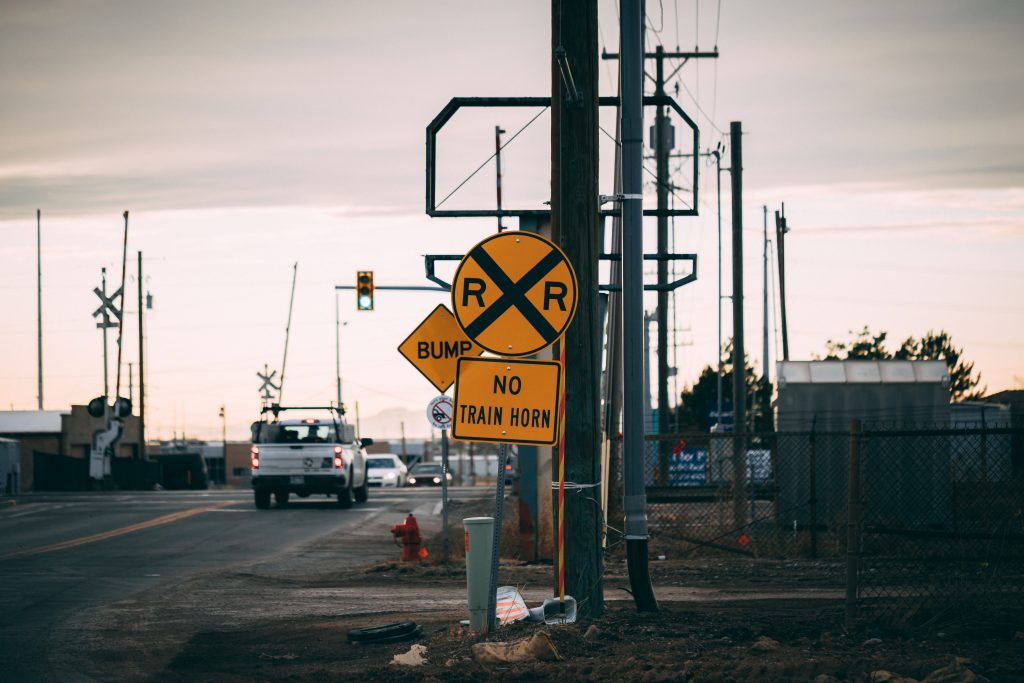
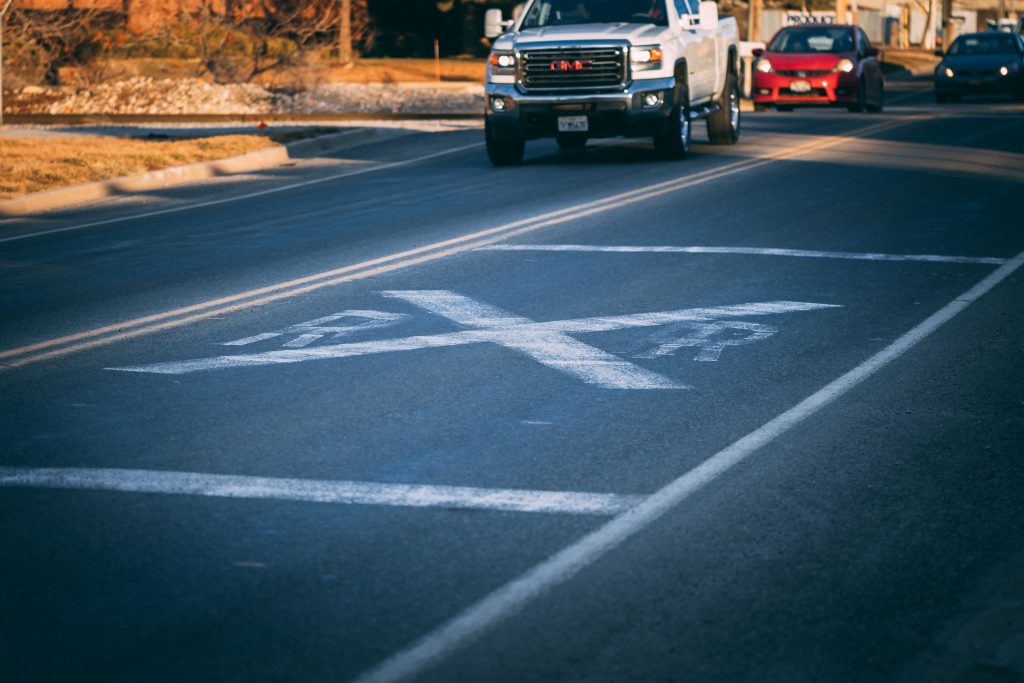
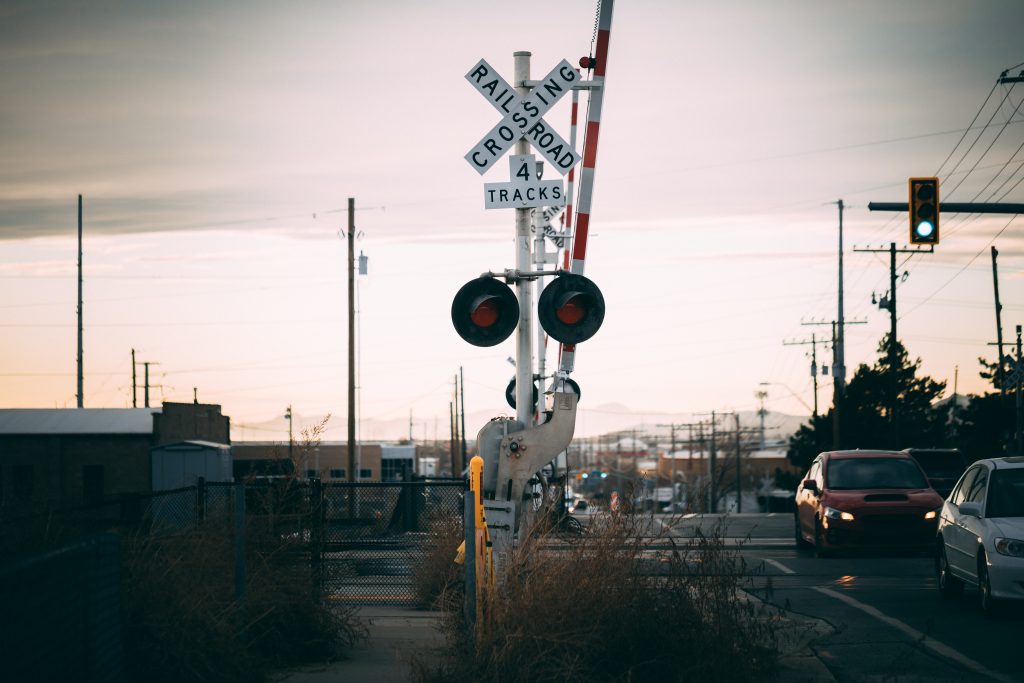
3. Driving Procedures
- Never race a train to the crossing
- Don’t expect to always hear a train approaching
- Reduce speed before a railroad crossing
- Don’t rely on signals to warn you of an approaching train
- Double tracks = double check
- Crossings in cities and towns are just as dangerous rural crossings
4. Required to Stop
- The nature of the cargo is required by regulation to stop
- If required to stop use 4-way flashers, and use a pullout lane if available
5. Crossing the tracks
- Do not shift gears while crossing tracks.
- Crossing tracks for a typical tractor trailer takes about 14 seconds to cross a single track, 15 seconds for a double track.
6. Special Situations
- Trailers with low clearance space underneath are more likely to get stuck on tracks.
- If you get stuck on tracks, get out of the vehicle and away from the tracks, call 911 and look for identification information for the crossing you are at.
Mountain Driving
1. Safe Speed
- Never exceed the “maximum safe speed” limit if posted.
- Take into account the length and percentage of the grade you are about to descend.
- Use the braking effect of the engine as the main method of braking going down a mountain or any grade.
2. Selecting a Gear Before Descending
- Chose your gear before descending, because once you start descending choosing a lower gear will not be possible if your speed starts building.
- If you are unable to get into gear you will lose all braking power of the engine.
- Older trucks rule of thumb is use the same gear to go down a hill that you used to climb it.
- Newer trucks may need to use a lower gear going down a hill than climbing it.
3. Brake Fading or Failure
- Brakes that are out of adjustment can fade leaving the brakes that are in adjustment to do all the work and possibly lead to losing control or braking power.
4. Proper Braking
- After a lower gear is selected for descent, apply steady pressure to the brake pedal to bring you to 5 mph below the “maximum safe speed” and release the pedal.
- Use the braking power of the engine as the main braking method.
5. Escape Ramps
- If you are ever in a situation where your brakes fade and you lose all braking power there are escape ramps on many major mountain grades.
- Escape ramps are designed to save the driver and passengers of a runaway vehicle.
- They are long deep, loose gravel, or sand runways sometimes uphill or in a straight path.
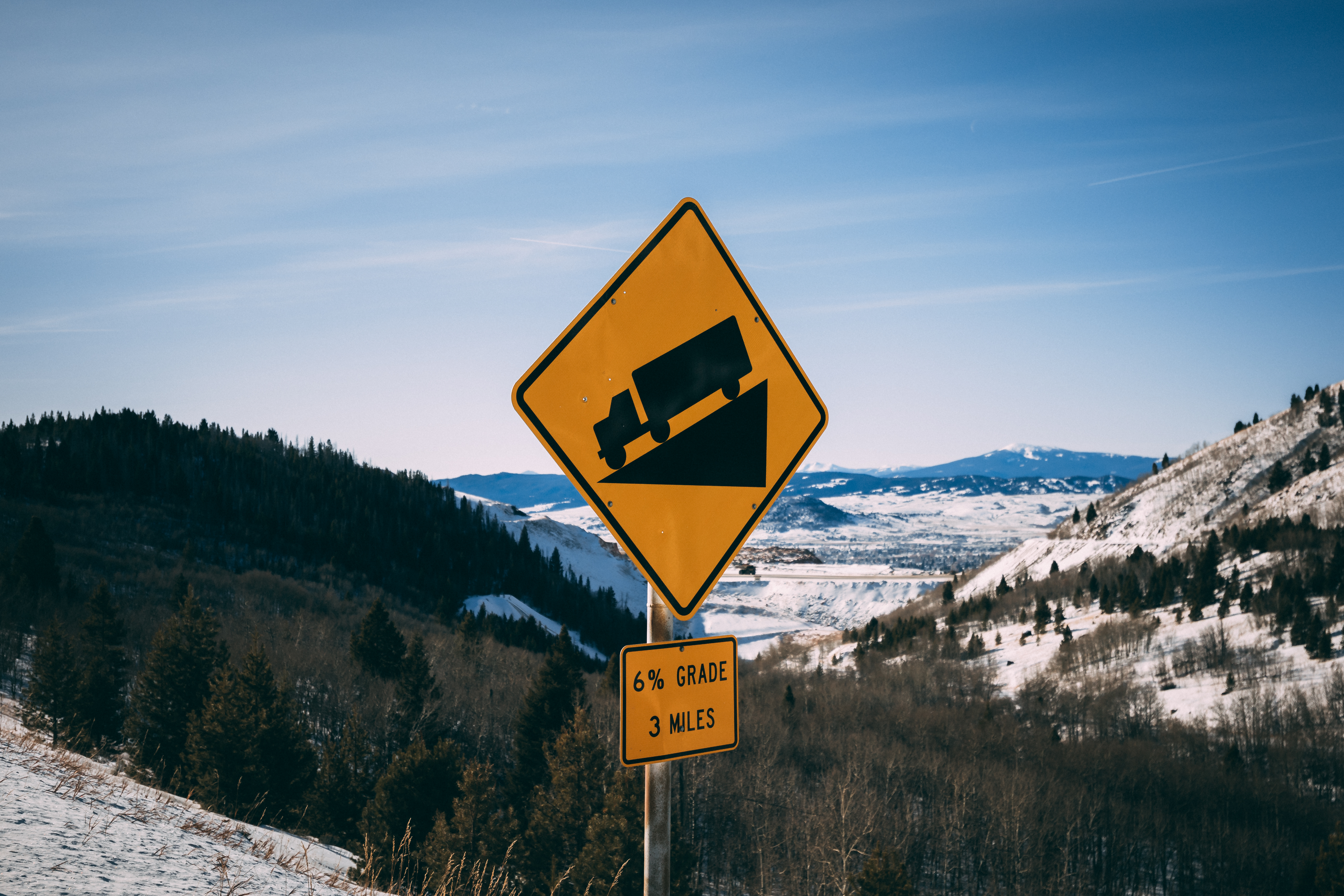
Driving Emergencies
1. Steering to avoid a crash
- Steering away can sometimes be safer than stopping if you have the space.
- Avoid unnecessary braking until your speed drops below 20 mph to avoid skidding on a loose surface.
- Keep wheels on pavement when possible.
- Stay on shoulder if you end up over there until you can stop and re-enter traffic.
- If you need to return to the road surface do so carefully and quickly. If you come on gradually your tires are likely to grip the road unexpectedly and you may lose control. If you come on quickly you need to steer quickly onto the road, and then immediately counter steer when the second steer tire hits the pavement.
2. Stopping Quickly
- Controlled Braking: applying the brakes steadily as hard as you can without locking up the wheels.
- Stab Braking: apply the brakes all the way until the wheels lock up then release and repeat as the wheels begin to roll again.
3. Brake Failure
- Loss of hydraulic pressure: Pedal will feel spongy or go all the way to the floor.
You can slow down by:- Downshifting
- Pumping the brakes
- Use the parking brake
- Finding an escape route
- Brake fade on long hill
- You need to look for an escape ramp or something outside your vehicle to stop it. Other options include an open field, or a side road that is flat or goes uphill.
- Act quickly, the longer you wait the more speed you gain and the harder it will be to stop.
4. Tire Failure
- Know the signs of tire failure
- A loud bang
- Vibration or thumping
- Steering feels heavy, or trailer moves side to side, “fishtailing”
- When your tire blows
- Hold steering wheel firmly
- Don’t press the brakes until the vehicle has slowed down
- Get out and look at all tires
Anti-lock Braking System
ABS is a computerized system used to slow a vehicle effectively without locking up the wheels during a hard braking condition.
1. Vehicles requiring ABS
- Truck tractors with air brakes built on or after March 1, 1997
- Other air brake vehicles built on or after March 1, 1998
- Hydraulically braked trucks and buses with a GVWR of 10,000lbs or more built on or after March 1, 1999
2. Knowing if your vehicle is equipped with ABS
- Vehicles will have a yellow ABS malfunction indicator on their instrument panel
- Trailers will have a yellow ABS malfunction light on the, front or rear, left side.
- Dollies manufactured on or after March 1, 1998 are also required to have a yellow indicator light on the left side.
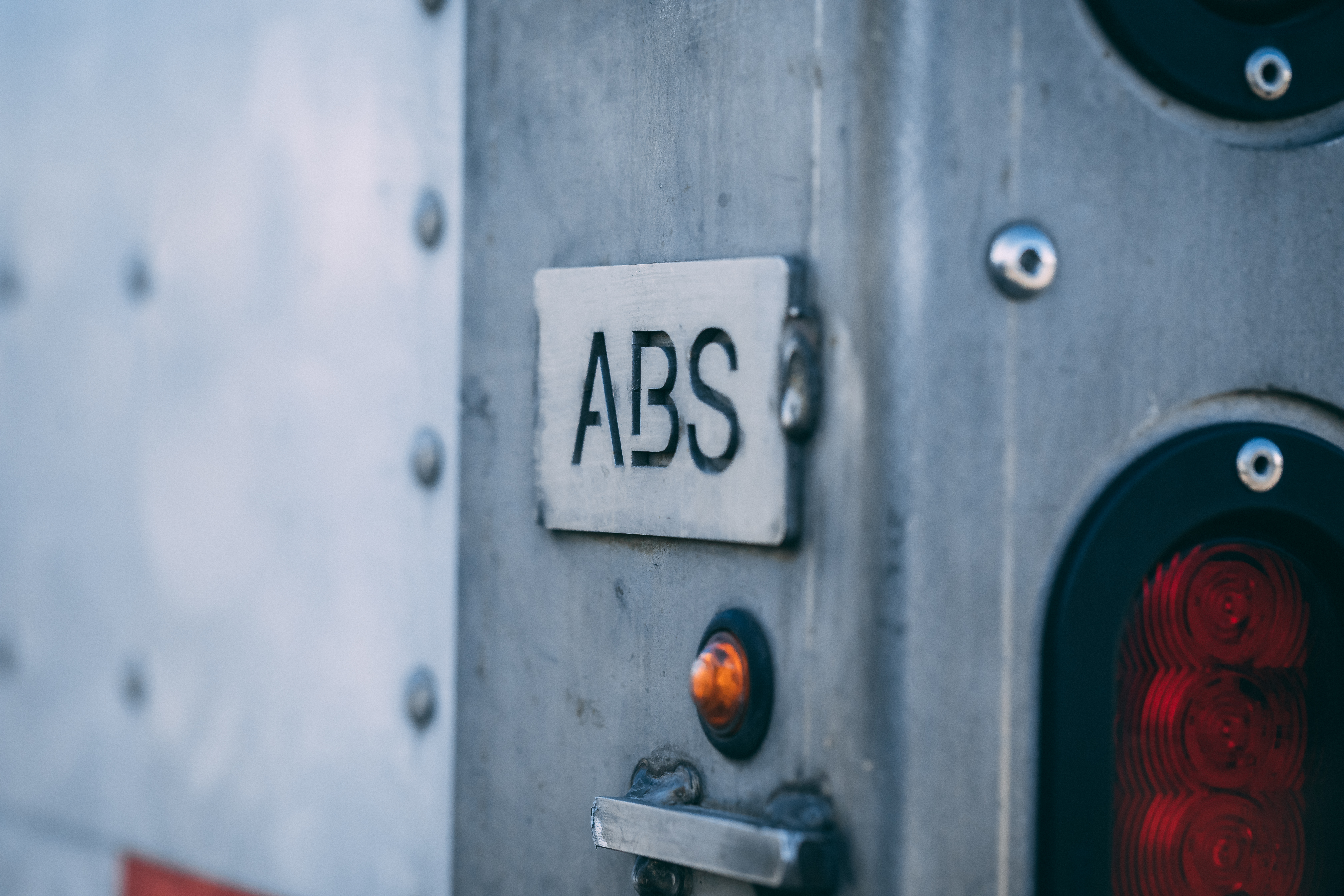
3. ABS on the tractor or trailer ONLY
- Having ABS even on a single axle gives you more control while braking a vehicle than having no ABS at all.
- ABS on tractor ONLY: Steering control should be maintained and jackknifing is less likely, but still possible.
- ABS on trailer ONLY: trailer is less likely to swing out, but you can lose steering control.
- Brake in a vehicle with ABS the same way you have always have!
Skid Control and Recovery
1. Skids Happen Because…
- over-braking
- over-steering
- over-accelerating
- driving too fast
2. Drive-wheel skids
- Most common skid is a rear wheel skid, usually due to excessive braking or accelerating.
- Acceleration skids occur commonly on ice or snow
- Rear wheel skids lead to a sideways motion of the rear of the vehicle. In a strait vehicle the effect is a “spin out”, in a combination vehicle the spinning of drive tires will lead to a jackknife.
3. Drive-wheel skid (combination vehicle)
- To correct skidding, stop braking, then counter steer.
- Staying off the brake and counter steering properly in this situation takes a lot of practice.
4. Front-wheel skid
- Front-wheel skids can occur due to driving to fast for conditions, lack of tread on steer tires, or not enough weight on the front axel.
- You can know a front-wheel skid due to the inability to steer the vehicle, where the vehicle will travel strait regardless of your turning of the steering wheel.
- To stop the skid you need to let the vehicle slow down, and avoid braking and steering hard.
Accident Procedures
1. Protect the area
- Move your vehicle out of traffic.
- If you are stopping to help an accident, stop away from the scene to leave room for emergency vehicles.
- Use 4-way flashers, and set out your triangles or flares to warn other drivers
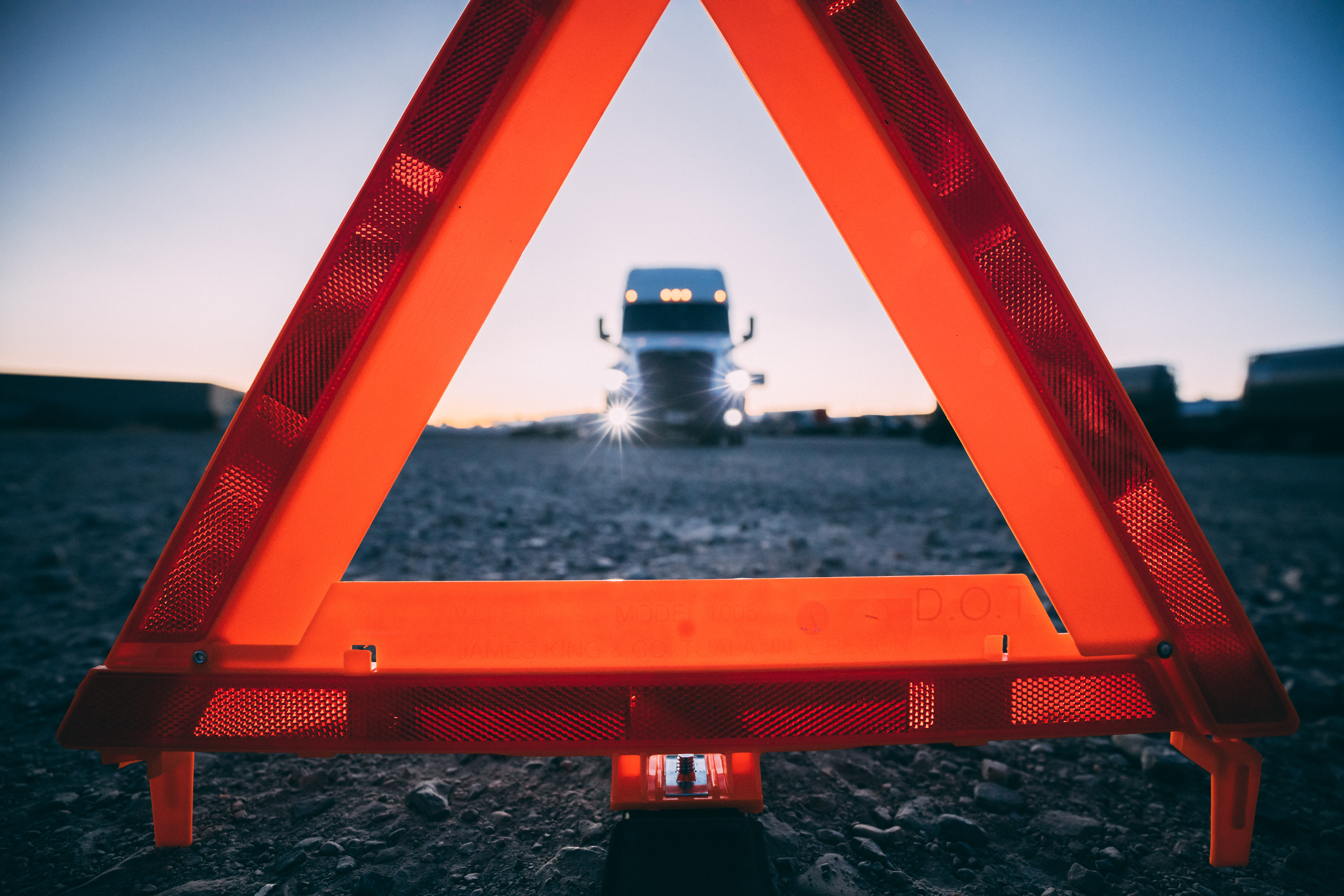
2. Notify Authorities
- Call for assistance while you are still in your vehicle.
- Attempt to determine your location for the authorities
3. Care for the injured
- Don’t move a severely
injured person unless they are in direct danger, like a fire. - Stop heavy bleeding by applying pressure to the wound.
- Keep an injured person WARM
Fires
1. Causes
- After an accident: spilled fuel, improperly used flares.
- Under inflated tires or touching dual tires
- Short circuits and loose connections
- Driver smoking, improper fueling, or loose fuel connections
- Flammable cargo, improperly sealed or loaded cargo, poor ventilation
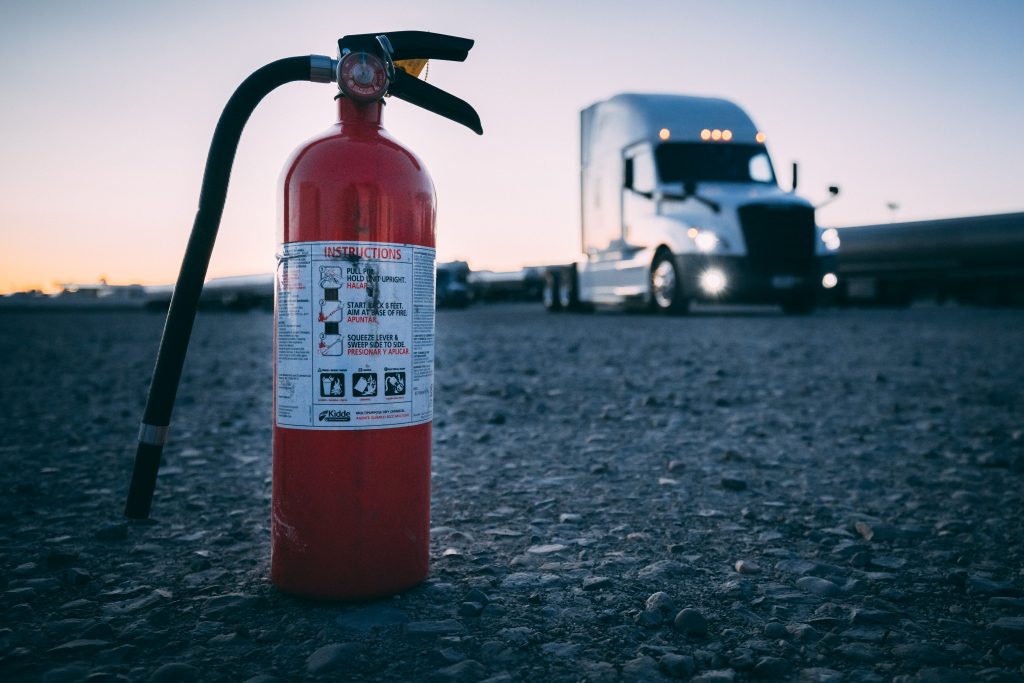
2. Prevention
- Make sure you do a thorough pretrip and ensure your fire extinguisher is fully charged.
- Also monitor and check your equipment during a trip
- Follow safe procedures
- Monitor instruments, gauges and equipment
3. Fighting Fire
- Pull off the road – park in an open area, notify emergency services
- Stop the fire from spreading
- Extinguish fire
Alcohol, Other Drugs and Driving
Don’t drink alcohol or do drugs and drive. Time is the only way to sober up.
Hazmat Rules For All Commercial Drivers
1. Hazardous Materials
- Materials that pose a risk to health, safety and/or property during transportation.
2. Rules
- If hauling hazardous materials you are responsible to contain and communicate the existence of the hazard.
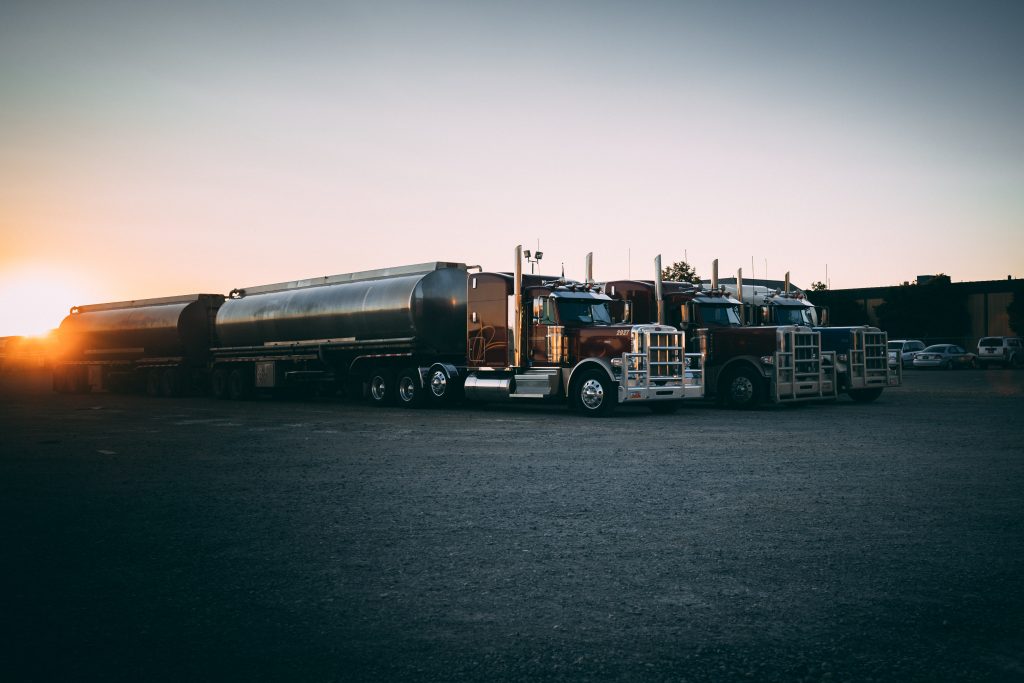
3. Placards and Identification Numbers
- A vehicle needing placards must have 4 identical identifying placards.
- The placards must be placed on the front, rear, and both sides of the hazardous container (vehicle or trailer).
- Identification numbers are used by first responders to identify hazardous materials.
- Not all vehicles containing hazardous materials need placards.
- You only need a hazmat endorsement to haul hazardous materials needing placards.
Section 3: Transporting Cargo Safely
Inspecting Cargo
- Inspect your load security after the first 50 miles of your trip
- Re-check your load after you have drive 3 hours or 150 miles
- Re-check your load after ever break your take during the trip
Weight and Balance
1. Definitions
- Gross Vehicle Weight Rating (GVWR): the loaded weight of a single vehicle.
- Gross Combination Weight Rating (GVWR): the loaded max weight of a combination vehicle.
- Axle Weight: The weight of a single axle
- Tire load: The maximum load a tire can carry at a specified pressure. Rating is on the side of each tire.
- Suspension System: The system that allows you to carry a rated load weight.
- Coupling Device Capacity: These devices will have rated towing and carrying capacities.
2. Legal Weight Limits
- GVWRs and axle weight restrictions are usually imposed state by state in relation to their bridge weight limits.
- A bridge formula will help determine the maximum axle weight limit. Larger weights will have to have axles further apart to regulate long baring at a single point.
- Over loading a truck can lead to labored steering, slow uphill climbs, harder stopping, and possibly brake failure.
3. Don’t Load Top Heavy
- Having a higher center of gravity (being top heavy) can make it easier to flip over the vehicle.
- Having a lower center of gravity is important especially on curves and having to perform emergency maneuvers like swerving.
Securing Cargo
1. Blocking and Bracing
- Blocking can be used around and in between a load to keep the load from sliding and shifting.
- Bracing cargo also prevents the load from sliding and shifting by creating a barrier from the top to bottom of the edge of a load or from side to side.
2. Cargo Tie-Down
- If you are hauling cargo on a flatbed or any trailer without sides you must tie-down your load.
- If you are using tie-downs you need to make sure they are rated for the strength your load requires.
- The securing devices used must be rated to handle at least half times the weight of the material being secured.
- No matter the weight of the load, you must have ONE tie-down per 10 ft of cargo.
- All loads are required to have at least 2 tie-downs.

3. Covering Cargo
- You cover cargo to secure cargo and protect it from weather.
- If you tarp a load you need to make sure the tarp is secured and not flapping, blocking your view or exposing your load.
4. Sealed and Containerized Loads
- Containerized loads are usually used in intermodal transportation.
- Many containers are loaded onto trailers that frame the container and secure it for transport, if you are hauling it on a flat bed you will have to secure it properly.
Cargo Needing Special Attention
1. Dry Bulk
- Dry bulk tanks have a higher center of gravity and require more care when driving around curves and sharp turns.
2. Hanging Meat
- Hanging meat is an unstable load with a high center of gravity and requires the same care as any high center of gravity load.
3. Livestock
- Livestock can move and shift in the trailer, keeping them bunched together makes the effect less.
- While on curves livestock can lean shifting the center of gravity.
4. Oversized Loads
- Oversized loads require special permits.
- Driving can be limited to certain times.
- Special indicators may be required such as “wide load” signs, flashing lights and red marker flags.
- Some loads require pilot vehicles and/or police escorts.

Now that you have finished General Knowledge be sure to also study the Air Brakes and Combination Vehicles sections.



